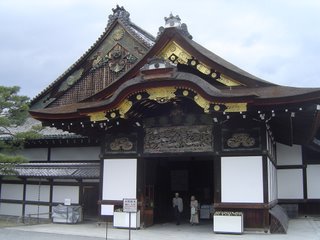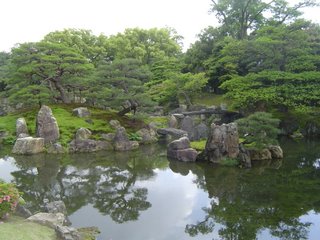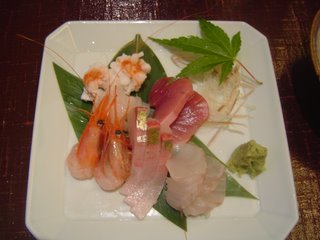Day 8: Nijo-jo Castle
 This morning I awoke at 7:30am, since we don't have school today. Junpei, Mr. Hotta, and I planned to walk to their plot of crops and pick some fresh strawberries for breakfast. Mr. Hotta's shortcut led us through a nearby park. After nearly stepping in a pile of dog poop he turned and said to me, "Careful. Dog's shit." I couldn't help but laugh a little. Anyway, the plot of land they grow on is only about five blocks away from their house. Junpei and I walked up and down the rows of crops, choosing the ripest strawberries to bring back to the house.
This morning I awoke at 7:30am, since we don't have school today. Junpei, Mr. Hotta, and I planned to walk to their plot of crops and pick some fresh strawberries for breakfast. Mr. Hotta's shortcut led us through a nearby park. After nearly stepping in a pile of dog poop he turned and said to me, "Careful. Dog's shit." I couldn't help but laugh a little. Anyway, the plot of land they grow on is only about five blocks away from their house. Junpei and I walked up and down the rows of crops, choosing the ripest strawberries to bring back to the house.The plan for the day was to see the Nijo-jo (castle) and go out for dinner later on. The Nijo-jo is a large complex which has a great deal of significant history to it. When I was studying Japan in my Modern East Asia class we covered Japanese history, some of which I have found out took place at the Nijo Castle! The Nijo Castle was built by the Tokugawa Shoguns, but was never really a permanent residence. Instead, the Castle was used to showcase the power and wealth of the Shogunate to others. The history I learned about surrounded Japan and the resistance of the traditional nation to the impeding ways of the West:
In 1863 Shogun Tokugawa Iemochi came from Edo (Tokyo) to the castle to consult with the emperor, the first such visit in two centuries, an unheard-of action during the previous 260 years. Here he received the emperor Komei's instructions to "expel the barbarians" who were attempting to open Japan to international commerce (Martin & Martin 2002, Kyoto: A Cultural Guide).
The phrase that sparked the memory of my studies was expel the barbarian. The phrase came to be the slogan for those Japanese who wished to continue the tradition of Japan rather than open themselves to the world. It might be boring to some, but it was exciting for me to make the connection.

 Most of the interior of the Nijo-jo is large rooms of tatami mats. Unfortunately, they do not allow pictures of the inside of the Castle. In each room there are hand-painted sliding panels, colorful tatami trim, and extravagant gold ornaments decorating the large wooden beam. The paintings were beautiful and unique to each room. For example, in the room where the Shogun kept the weapons, the paintings are of several large hawks perched in trees as they prepare to attack. The panels above those which slide are magnificent hand-carved scenes of nature. The best carving, in my opinion, is of a large peacock and its colorful feathers. The castle has awesome detail wherever you look: the ceiling panels are painted and differ from hallway to hallway, the gold ornaments are all different, and the tatami is lined with fabric of different designs. What surprised me the most was the floor in the hallways. The floors appear to be simple wood planks, but one step upon them and you will notice right away what makes them so special: the boards make the chirping sounds of Japanese Knightingale when stepped upon! They actually designed clamps to hold the floorboards down that would make a footstep sound like the beautiful singing of a knightingale. I was hopping around the floor to hear all the different pitches and it really sound like birds! The rock gardens outside of the castle were simply breathtaking.
Most of the interior of the Nijo-jo is large rooms of tatami mats. Unfortunately, they do not allow pictures of the inside of the Castle. In each room there are hand-painted sliding panels, colorful tatami trim, and extravagant gold ornaments decorating the large wooden beam. The paintings were beautiful and unique to each room. For example, in the room where the Shogun kept the weapons, the paintings are of several large hawks perched in trees as they prepare to attack. The panels above those which slide are magnificent hand-carved scenes of nature. The best carving, in my opinion, is of a large peacock and its colorful feathers. The castle has awesome detail wherever you look: the ceiling panels are painted and differ from hallway to hallway, the gold ornaments are all different, and the tatami is lined with fabric of different designs. What surprised me the most was the floor in the hallways. The floors appear to be simple wood planks, but one step upon them and you will notice right away what makes them so special: the boards make the chirping sounds of Japanese Knightingale when stepped upon! They actually designed clamps to hold the floorboards down that would make a footstep sound like the beautiful singing of a knightingale. I was hopping around the floor to hear all the different pitches and it really sound like birds! The rock gardens outside of the castle were simply breathtaking.For lunch, the Hotta's and I drove to a noodle shop near the Nishi market in Kyoto. I was looking forward to comparing the ramen noodles which are a staple of any American college student to the ramen in Japanese noodle shops. It goes without saying that the Japanese version was much better. After lunch we had to go to Daimaru, the large department store, to get Junpei's glasses fixed; his glasses got a little bent up when he got hit in the head during a game of dodgeball...poor kid. We then dropped Junpei off at a school where he gets private English lessons. Japanese students are forced to study very hard in order to get into good junior high and high schools. Most kids who attend Notre Dame Elementary have extra lessons and also go to ju ku (cram school).
 Junpei's parents and I went home to relax for a while before dinner. Meanwhile, the Hotta's invited me to stay for two more nights! I was scheduled to be staying at my room at school, but the Hotta's wanted me to stay longer. I really love the Hotta family and it will be hard to leave them. For dinner we drove to a nearby restaurant which the Hotta's frequent. It was a cute little place with raised wooden floors so that you could kneel at your table or put your legs underneath. We had some sashimi, tempura, salad, fried noodles, and other delicious foods. I was surprised to learn that "suzuki" is the name of the fish we know as Perch. Our sashimi plate included some Perch, Tuna, Conger, and shrimp.
Junpei's parents and I went home to relax for a while before dinner. Meanwhile, the Hotta's invited me to stay for two more nights! I was scheduled to be staying at my room at school, but the Hotta's wanted me to stay longer. I really love the Hotta family and it will be hard to leave them. For dinner we drove to a nearby restaurant which the Hotta's frequent. It was a cute little place with raised wooden floors so that you could kneel at your table or put your legs underneath. We had some sashimi, tempura, salad, fried noodles, and other delicious foods. I was surprised to learn that "suzuki" is the name of the fish we know as Perch. Our sashimi plate included some Perch, Tuna, Conger, and shrimp.


0 Comments:
Post a Comment
<< Home